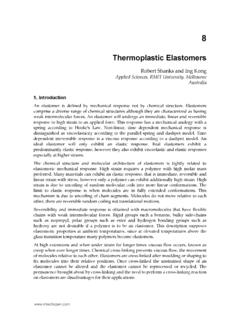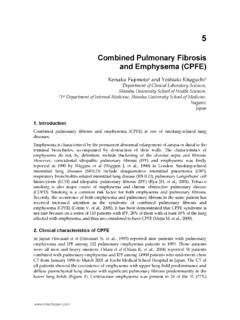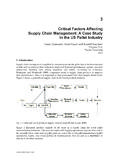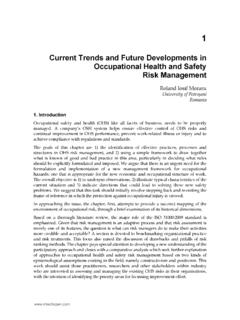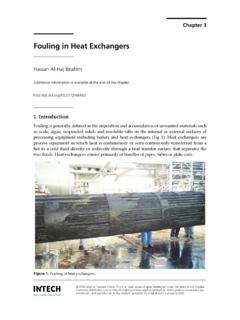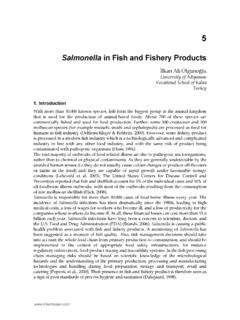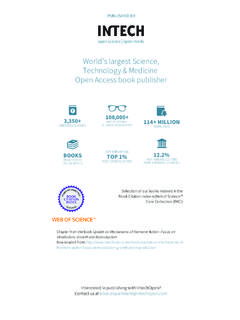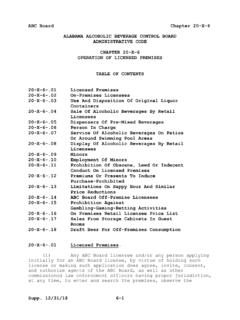Transcription of Procedures of Food Quality Control: Analysis Methods ...
1 5 Procedures of Food Quality control : Analysis Methods , Sampling and Sample Pretreatment Nancy Ornelas-Soto1, Oracio Barbosa-Garc a1 and Pedro L. Lopez-de-Alba2 1 Centro de Investigaciones en ptica, Le n, Gto. 2 Departamento de Qu mica. Universidad de Guanajuato. Gto. M xico 1. Introduction The development of new Methods that might or might not involve sophisticated techniques for the Quality control of food products continues increasing according to consumer requirement of food safety and authenticity issues. The production of fakes is a worldwide problem that includes food products. Some examples can be found on olive oils, honeys and alcoholic beverages such as table wines and spirits (Contreras et al., 2010; Gallardo et al, 2009; Marcos et al., 2002; Zhang et al.)
2 , 2001; Zhu et al., 2010). Therefore, food authentication concerns both authorities and food processors to avoid the unfair competition from counterfeiters who exploited the economic advantage by producing and selling fake food products. Food companies have adopted different strategies to improve the positioning of their brands on the market. These strategies not only include the food Quality control based on the identification and reduction of forbidden compounds but also on monitoring the key compounds that enhance the food value. In this chapter a practical review of Methods for Quality control on compounds and on the confirmation of food authenticity is presented. Non-destructive testing sample methodologies that have found new applications in the field of Quality assurance are discussed in terms of their potential use in food industry.
3 Thus, the use of spectroscopic techniques with chemometric Analysis for the classification of food samples based on Quality attributes is also discussed in this chapter. The optimization of the analytical Methods is based on the selection of fundamental working conditions (sampling, pretreatment, selectivity, linearity, range determination, sensitivity, limit of detection, precision and accuracy, etc.) according to which the suitability of a selected method might be evaluated. One of the most important steps in the analytical method for compound determination in biological matrices is the sample pretreatment. The purpose of a pretreatment is to release analytes from compounds and phases as well as to remove components which have adverse impacts on the analytical signal.
4 On the other hand, before any analytic treatment it is necessary to take into account some preliminary Procedures that involve statistic Analysis (Cochran, 1977; Hinkelmann & Quality control of Herbal Medicines and Related Areas 64 Kempthorne, 1994). When making surveys within different research fields, the access to the entire population of items/subjects/individuals/samples is almost impossible and expensive and thus, sampling techniques come into play. Industry and business make use of sampling techniques to increase the efficiency of their internal operations. In particular, for industry sampling techniques are important tools for Quality control to ensure that final items are ready for marketing. In particular, for food processing decisions regarding any change on the Quality control to accept or reject lots would be well grounded if the selected data from the population is done with the appropriate sampling technique.
5 In this way you can be confident that your decision about acceptance or rejection of lots is right. That is, sampling Procedures are focused on the selection of a subset of sample observations within a population attempted to yield some knowledge about the entire population of concern. Sample observations bring out data values of some measurable properties of the subject. Therefore, the cost of collecting data about a population by gathering information from a subset instead of the entire population is reduced. In addition to this, making use of the appropriate sampling technique the data can be collected and summarized more quickly since the data set is smaller and the accuracy and Quality of the data can be improved.
6 Therefore, this chapter starts with the sampling Procedures followed by the most common analytic Methods focused on food Quality control . 2. Sampling Procedures If the population regarding any survey is almost impossible to reach and expensive to try every single sample, then how large should the subset of samples be to ensure that the results obtained from it would be generalized? A single answer to this question is not possible. However, it is clear that the larger the sample size the more closely your sample data will match that from the entire population. For sampling Procedures one counts with the probability sampling and non-probability sampling Procedures . The probability sampling procedure refers to a given population where one is able to identify distinct samples; each possible sample has some known probability of selection and thus, one can select, and identify, any sample through a random process.
7 That is, each sample within the population has its own probability to be randomly selected. In contrast, the non-probability sampling procedure refers to the case when the sample to be selected is part of the population that is readily accessible or it might occur that the population consists of volunteers or that the samples were haphazardly selected. In any case, for this procedure some samples have no chance of selection and information about the relationship between samples and the entire population is very limited. For the non-probability sampling no known probability is assigned to the samples of the population and it will almost certainly contain sampling biases. When the sample is selected on a random basis 3 main types of random sampling techniques can be identified, , the simple random sampling, stratified random sampling and systematic sampling.
8 For the simple random sampling method, any sample from the population has an equal chance of being drawn, that is, every sample has the same probability of being selected. If the selected sample is removed from the population for subsequent draws, then the method is random sampling without replacement. However, if the selected sample is not removed from the population in such way that for any new draw the population remains fixed to the original, then the simple random sampling is without replacement. Procedures of Food Quality control : Analysis Methods , Sampling and Sample Pretreatment 65 The stratified random sampling method is based on the fact that sometimes the entire population might embrace certain number of distinct samples which would be divided into subpopulations.
9 If this is the case, these subpopulations are called strata and the sum of them is the total population. For stratified random sampling each stratum is sampled independently and each individual in the subpopulation is randomly selected, , a simple random sample is taken in each stratum. For this method, each subpopulation can be considered as independent and thus each stratum is a population in its own and one is able to get inferences from each of them. When the population can be ordered in some scheme and the samples are drawn at regular intervals through that ordered list, then the sampling method is called systematic sampling. For this method and to start the sampling is convenient to select the first sample randomly and then drawn the next samples at regular fixed intervals till the end of the list.
10 That is, the first element to draw should be selected randomly instead of selecting the first of the list. Notice that for this method the complete list defines a stratum and each regular interval defines a stratum that contains the fixed number of elements defined by the interval. Thus, the difference between this method and the stratified is that the former is defined by regular strata and each individual occurs at the same relative position within the stratum. On the other hand, for the later the strata might not be regular and the individuals are selected randomly in each stratum. Normal distribution By doing a survey with the appropriate sampling method one ends up with a collection of data that represents the measurement of one or more properties of the chosen samples from the given population.


